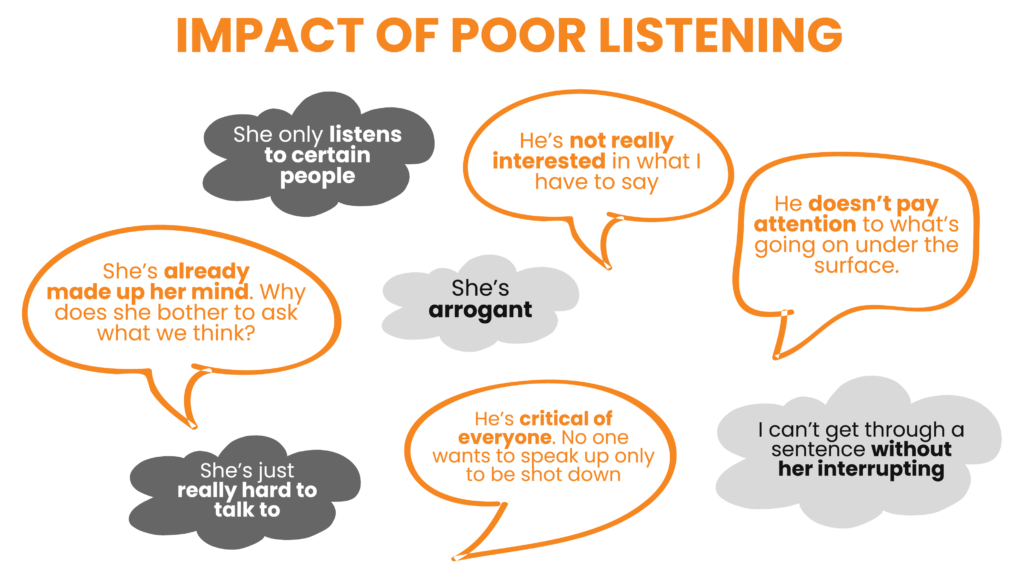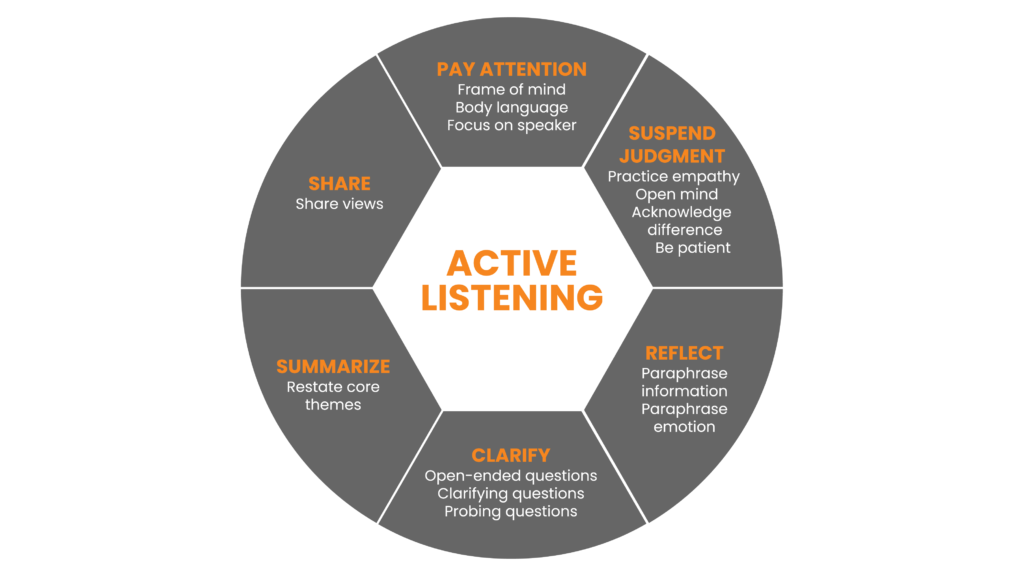Leadership often calls for more than just the ability to manage but also to coach. Knowing when to manage and when to coach is an essential part of the job. Stack (2014) summarized the different situations which call for managing vs. coaching.
| Wear the manager hat when… | Wear the coach hat when… |
| • crises erupt requiring quick and positive results. • dealing with new and inexperienced staff handling new tasks. • driving for completion of low-level, unpopular tasks. • time is of essence with looming difficult deadlines. |
• guiding and supporting staff towards career goals. • collaborating with team to define and facilitate best strategic direction. • driving for transparency by sharing mission, vision, and goals. • inspiring and inviting team on the journey to success. facilitating progress towards set individual and organizational goals. |
Whether I’m wearing my manager hat or my coach hat, I’ve come to realize how important communication skills are. In my previous post of this 4 part series on coaching, I wrote about the language of coaching covering the common language of good coaches. Since communication is a two-way process, of equal or perhaps even more importance in the equation of communication, is the ability to listen well. After all, Mark Twain once said that there is a reason why God gave us two ears and only one mouth – so that we would talk less and listen more. This week, I explore the mechanics of active listening and how coaches can become better listeners to coach more effectively.
What is Active Listening
The communication process involves not just speaking and hearing what the other person is saying but also construct meaning from the verbal and nonverbal signals sent by the speaker (Janasz et al., 2006)
There are different types of listening (Janasz et al., 2006)
- Passive Listening – listener is focused on trying to absorb as much information as possible
- Attentive Listening – listener is genuinely interested in the speaker’s viewpoint
- Active or Empathetic Listening – listener needs to do the most work making it the most powerful level of listening.
According to Hoppe (2006), active listening is “a person’s willingness and ability to hear and understand. At its core, active listening is a state of mind that involves paying full attention to the other person, avoiding premature judgment, reflecting understanding, clarifying information, summarizing, and sharing”.
“If you think you know it all, then you haven’t been listening.”
~ La Rochefoucauld
Why is Active Listening Important
Leaders with poor listening skills dampen employee morale which in turn leads to reduced productivity. Leaders lose respect from staff members who feel that the leader is arrogant and does not care enough to listen to the team (Hoppe, 2006).

Having strong active listening skills, on the other hand, is a powerful tool leading to a more productive organization. It is an invitation for others to listen to you and it shows the speaker that the leader cares and is concerned about what they have to say. It helps the leader gather better information as active listening encourages further communication. Active listening also has the potential to enhance relationships and leads to better cooperation and problem solving (Janasz et al., 2006).
Barriers to Effective Listening
There are many barriers to effective listening. Understanding what these barriers are can help us to produce and facilitate an environment that promotes active listening. Hoppe (2006) lays down these points as barriers to effective listening:
- The image of leadership – leaders feel the need to speak more due to the need to maintain an image of an action-oriented, charismatic, visionary leader and listening seems to be a passive act which contradicts that notion.
- Silence as agreement – listening quietly can sometimes be misconstrued as acceptance or agreement. Active listening does not mean holding back opinions and objections but rather allowing sufficient time to learn, uncover assumptions and seek clarity before doing so.
- External pressures – operating in a volatile, uncertain, complex, and ambiguous environment makes it more difficult to listen well. Ironically, the ambiguous and volatile nature of the work environment increases the need for listening skills to solicit and make sense of information.
- Lack of know-how – the emphasis is often placed more on how to get the message out rather than on how to listen well, making listening a much neglected communication skill.
- Individual makeup – an individual’s experience and personality can also play a part in creating barriers to effective active listening.
- Time and place – Remote working may hinder effective communication especially when non-verbal cues are not available, for instance during telephone calls.
- Emotion – when dealing with strong feelings, we have a tendency to react a little too quickly or passionately when a little active listening could have gone a longer way in finding common ground for problem-solving.
- Cultural differences – our leadership, coaching, communication, and way of working are deeply connected to our cultural backgrounds. Routine or natural behaviors in one culture may not be construed the same way in a different culture. Hence, it is important to be mindful of our own assumptions in the course of active listening.
Janasz et al. (2006) add on to the list above with these barriers to effective listening:
- Lack of interest – disinterest in the speaker’s subject.
- Daydreaming – becoming preoccupied with an unrelated topic while listening.
- Distraction – distraction by external noise from phone calls, emails, other conversations, etc.
- Point of focus – focusing on the speaker’s mannerisms or delivery instead of on the message.
- Detouring – train of thought veering off to a different topic because of what the speaker said.
The Active Listening Skill Set
Coaches who are good active listeners have the ability to draw out of their learning partners more meaningful information. When practiced well, active listening helps participants find common ground, connect with each other, and open up new possibilities for collaboration (Hoppe, 2006).
There are six key skills in active listening – paying attention, suspending judgment, reflecting, clarifying, summarizing, and sharing. Each skill is equally important and includes various techniques and behaviors. Multiple skills can be in use during the course of active listening (Hoppe, 2006).
1/ Pay Attention
Set a comfortable tone, allowing the speaker the space to think and speak. Cultivate an active listening mindset by getting into the frame of mind to be a listener and learner. Also, show interest and watch your body language – maintain eye contact, lean forward, maintain open body position and posture, nod to show understanding, and give nonverbal affirmations. Focus on the speaker and pay attention to both verbal and nonverbal behavior.
2/ Suspend Judgment
Having an open mind is essential to effective active listening. Refrain from making hasty judgments and do not jump into problem-solving mode or start offering advice too quickly. Practicing empathy, patience, acknowledging differences, and indicating an open mind goes a long way towards effective active listening.
3/ Reflect
Reflecting is a method to indicate that you hear and understand the speaker. Practice reflecting information and emotions without either agreeing or disagreeing. Use the paraphrasing method to restate the speaker’s ideas and facts presented. Also, learn to identify the feelings accompanying the content of the message as the speaker is speaking. This lets the speaker know that you are paying close attention and is invested in understanding what the speaker has to say.
4/ Clarify
If anything is unclear, use open-ended, clarifying, and probing questions to seek clarity. These questions encourage the speaker to expand their ideas, helps clear up any confusion, and introduce new ideas or suggestions. They also invite reflection and a thoughtful response instead of coming across as being directive in prescribing what others should do.
5/ Summarize
Summarizing involves restating core themes raised and helps the speaker see their own key themes. As you listen, succinctly summarize your understanding of what was said.
6/ Share
Active listening does not mean listening passively but by being an active party in the conversation. Active listening emphasizes seeking to understand first before being understood. After understanding the speaker’s perspectives, it is appropriate for the coach to respond to address concerns and introduce ideas, feelings, and suggestions.

Active listening is absolutely essential in coaching and in leadership. When mastered, active listening can help coaches to understand their learning partner’s needs, interests, experiences, and perceptions (Foltos, 2013). It also helps leaders improve their ability to lead by becoming more effective listeners (Hoppe, 2006).
Don’t miss the other parts in this series on Successful Coaching:
- Successful Coaching Part 1: A Study on Coaching Effectiveness
- Successful Coaching Part 2: The Art of Changing Minds
- Successful Coaching Part 3: The Language of Coaching
References
- Foltos, L. (2013). Peer coaching: Unlocking the power of collaboration. Corwin.
- Hoppe, M. H. (2006). Active listening: Improve your ability to listen and lead. Center for Creative Leadership.
- Janasz, S. D., Dowd, K. O., & Schneider, B. Z. (2006). Interpersonal skills in organizations. McGraw-Hill.
- Stack, L. (2014, July 7). Managing vs. coaching? in today’s workplace, you really need both. TLNT. Retrieved November 7, 2021, from https://www.tlnt.com/managing-vs-coaching-in-todays-workplace-you-really-need-both/.


This is such an interesting post. I kept finding myself revisiting the list of barriers to active listening and considering the ways in which some conversational practices can sometimes act as barriers and undermine active listening, and the ways in which many of the solutions also seem like they would be effective in supporting inclusion. These seem to go hand in hand.
This is a wise essay on the role and importance of active listening, with many powerful tips to make one a better listener. They are so valuable, thanks for sharing. At one point early in the blog you note, “Leaders with poor listening skills dampen employee morale which in turn leads to reduced productivity.” It would be powerful for us in DEL to know what the impact is when a coach manifests poor listening skills?
Thank you for your feedback and question, Dr. Foltos. When a coach manifests poor listening skills, it might make the coachee feel disrespected and not worthy of attention. This may end up risking the foundational work of building trust. As a result, the coachee may end up sharing less out of fear of rejection or fear of saying something stupid. This could ultimately lead to unsuccessful coaching in the end.